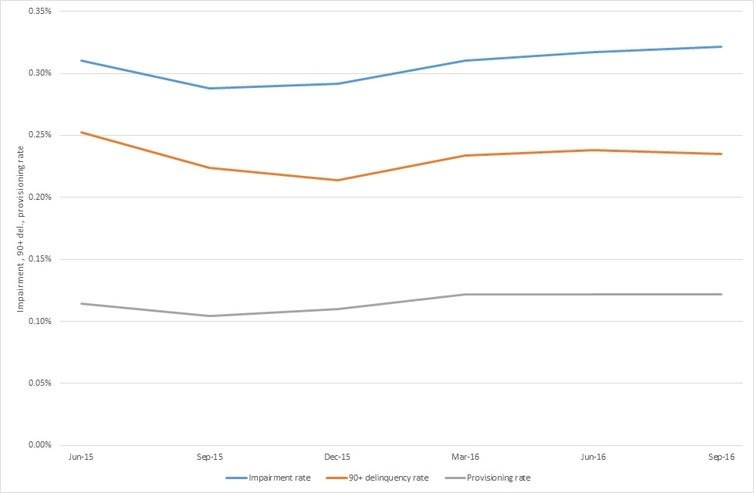More Australians are behind on their housing loans, how worried should we be?
![]()
GUEST OBSERVER
The number of Australians who are 30 days behind in their mortgage payments is at the highest level in three years, according to ratings agency Moody’s. It projects this will keep rising.
The question is, how worried should we be?
The increase in mortgage delinquencies is a warning sign for lenders. Moody’s analysed mortgages in residential mortgage-backed securities, which may differ from the loans on the books of the major banks. So it’s hard to say exactly how problematic this is right now.
But there are a number of factors that could make this situation worse, regardless of the current risk. My colleagues and I recently published research exploring the causes of loan losses. We found a lack of ready funds and declining housing prices to be key contributors. Future interest rate rises, then, are a concern.
Further, a key driver behind the rise of delinquencies is that wage increases have not kept up with recent house price increases, and this trend, too, is looking rather dire.
How banks report bad loans
Bank risk reports reflect a number of different metrics of how their loan books are doing. Let’s focus on loan delinquencies, impaired assets and provisioning.
In Australia, housing loans are defined as delinquent if the borrower does not meet scheduled payments. For example, they could be 30 days or more than 90 days late. A loan is considered impaired if it is likely to result in a loss to the bank - generally because there is not sufficient collateral backing the loan.
Provisioning is the money that banks allocate to cover the losses on bad loans, whether delinquent or impaired.
This chart, based on recent Commonwealth Bank reports, shows that none of these numbers are particularly high right now - representing less than half a percent of all the loans on the bank’s books.
Commonwealth Bank of Australia Basel III Pillar 3 reports. Commonwealth Bank
How bad loans affect banks
That chart isn’t the end of the story.
Generally speaking, delinquencies are forward looking. A 30-day delinquency has a strong potential to become a 90-day delinquency, eventually forcing the bank to start setting aside more and more money, and prepare for an impairment.
Bank provisioning follows guidelines set by the Australian Prudential Regulation Authority (APRA). The longer the loan is in arrears, the more money banks have to set aside.
For example, for a mortgage loan with an outstanding amount of 80-100% of the property value, the bank does not have to set aside any additional money for the first 90 days it is in arrears. But they must set aside 5% of the loan after 90 days, and 20% after a year. Larger provisions apply for commercial loans, especially if they are not secured against other assets.
This is why the Moody’s warning has to be taken seriously - 30 days can quickly become 90 days, putting more pressure on banks.
The state of the economy is also a factor
Not every delinquent loan results in a loss, however. Banks and borrowers often come to agreement on more lenient payment schedules which ‘cure’ delinquent loans and borrowers are able to make scheduled payments again.
The rate at which delinquent loans are cured often reflects the state of the economy. The following charts are based on US data and show us how the economy can factor into whether a loan is cured or goes bad. In a boom, cure rates are high and foreclosure rates low.
Another thing to note in these charts is that cure rates decrease significantly as the number of days in arrears increases.

Delinquencies that are ‘cured’ during a boom. author's analysis
In an economic bust, however, cure rates are low and foreclosure rates are high. There are many reasons for this – during a bust it is much harder for the unemployed to find jobs, for delinquent borrowers to sell other assets, and lenders are less willing to refinance.

Delinquencies that are ‘cured’ during a bust. author's analysis
Are Aussie banks in trouble?
In Australia the delinquency rates are currently well below those seen in the US during the global financial crisis (GFC). The delinquency rates there and then exceeded 5%.
But the conditions are there for bank losses to be realised. First, borrowers need to become delinquent (often as a result of job losses or interest rate increases). Second, house prices need to drop below outstanding loan amounts as banks only have losses if the houses do not repay the impaired loans.
Such a bust scenario may be unlikely but within reach. The job market is under pressure, interest rates are low and hence likely to rise in the longer term, and the outlook for house prices is mixed - with Melbourne and Sydney on the rise but cities associated with the mining sector heading down.
It is important to keep a close watch on these all factors, especially if they start to combine.
ssociate professor, Finance, UTS Business School, University of Technology Sydney and author for The Conversation. He can be contacted here.

